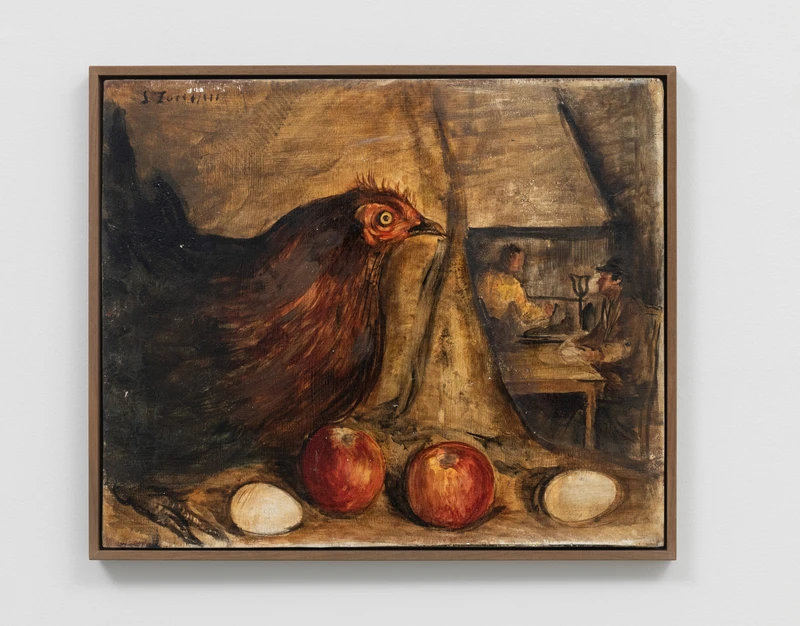Luigi Zuccheri
5 Jun-9 Aug 2025


The selection of works that you are lucky enough to see has the ambition of retracing the evolution of Luigi Zuccheri’s works from the onset of the Second World War to his death in Venice in 1974, in a few episodes. The works are presented in chronological order.
A year ago, the exhibition Subtle Hunts at Sylvia Kouvali in Piraeus introduced what we believe to be Luigi Zuccheri’s priority: the daily, delicate exercise of misanthropy through compositions that are devoid of narrative. At the same time, Zuccheri celebrates nature as an absolute, static and imperturbable value, all within exquisitely cerebral stagings.
In Zuccheri’s tempera paintings, the value of nature has nothing to do with human gratification, with our appreciation of the proportions and gentilities of the flora or the purity of form and behaviour of the fauna; on the contrary, nature has value for itself. The proportions of the subjects demarcate the fields: nature as a whole has its own scale, and maintains a dialogue between the elements; humans are smaller, extraneous to the composition and hence, to nature.
The scenes we witness in Zuccheri’s paintings have a regular structure, they seem to begin when each action has finished. More precisely, since human action has no development here, it has no temporal linearity and cannot be inscribed in the broader narrative of nature, of the seasons, of rhythms, of vitality. The human figure remains frozen in immobility, now only a memory preserved by the landscape in which it once lived; it remains in the collective memory of the weeds it once fought and which are now taller than a farmer.
Zuccheri did plot with nature as part of the process of his making, as Giorgio de Chirico, a close friend, described in Zuccheri’s obituary in 1974 as his “impassioned pursuit of all the secrets of tempera painting.” These technical experiments, the continuous search for new solutions and new colours to extract from that same nature add an almost alchemic level, painted with honey, with coffee grounds, with the clay he himself scoops up from the riverbeds. With these techniques that he himself described as recipes, he rails against guilty humanity, going as far as writing a book on the subject, Del Piturar a Tempera in 1966.
Let us now return to the paintings in question. As I said, we have attempted to delve into the evolutionary steps of Zuccheri’s grammar. We know that the Second World War was a time of great reflection for Zuccheri, his painting changed drastically between 1938 and 1945 when the more academic aspects of his work gave way to a troubled reflection on the fate of humanity.
This can already be seen in the domestic scene that opens the exhibition: Interior with chicken, pear, eggs and human figures, 1940/1945. Here the scene takes place in an interior, humans have a right to exist in this space, it is theirs. We notice connotations of vitality in these figures (they have expressions and eyes) that will become lost over the coming years, but the presence of nature already expresses a desire to prevail in a form of dichotomy with humanity. This tension will turn with time into a total detachment between the two spheres, or rather, an absolute disinterest of nature in humankind and his memory.
A short time later religious motifs appear, seen here in the painting Saint Jerome praying, 1948. Here we can see how the saint is still a vital figure, internal to the composition, the protagonist of it. The brief period between 1946 - 1949 when this work was produced, was a productive one for Zuccheri, and though we cannot go into the reasons that led him to have this mystical impulse, which we believe he embraced in life as much as in practice, we are certain that the horrors of war developed needs in him that religion could satisfy. In later works (from c.1955) friars and saints became instrumental characters in his compositions.
We continue now with a moment of staging, illustrated in Landscape with jay and human figures, 1955/1965. Here we see an intermediate step from the representation of nature as mental space. Here human rules are still applied: theatre as a method of making nature a place of representation, clouds as backdrops, the jay as protagonist performing as an actor. These motifs will become more implicit over the coming years, but it is interesting to analyse this intermediate phase in order to understand Zuccheri’s further consciousness-raising.
We are now faced with a painting that synthesizes many of the aspects encountered in previous works. In Composition with Weasel Eggs, Walnuts and Friar, 1960/65 we notice an anthropized background, a more marked disproportion, however the human figure has already lost its traits, becoming, as mentioned above: the sole simulacrum of its presence. It is particularly interesting to note that all this still takes place in an interior, in an atmosphere of suspension between geological eras.
From this point on, we will leave it to you to notice and enjoy the further, subtle developments of what has been introduced.
Text by MMXX